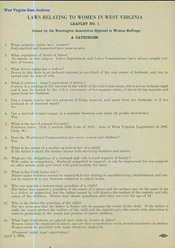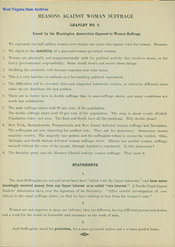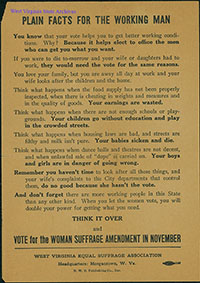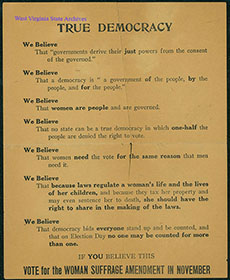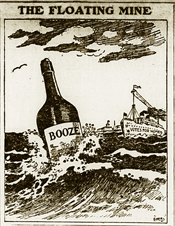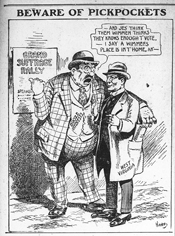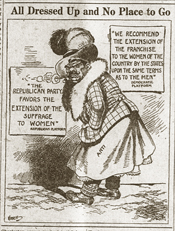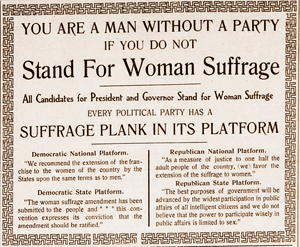
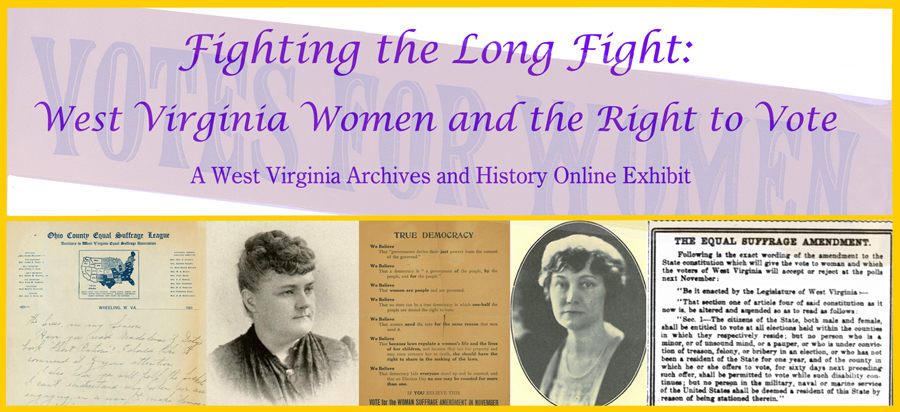
Chapter Four | ||||||||||||||||||||||||||
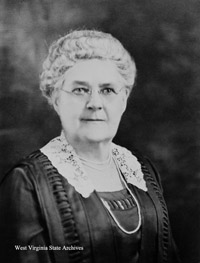 Harriet B. Jones. Boyd B. Stutler Collection, West Virginia State Archives |
Immediately on the heels of legislative approval of the resolution in late January 1915, Ida Craft held a suffrage school in Charleston from January 28 to February 3 to prepare West Virginia women for the campaign. At the same time, with permission of Governor Henry Hatfield, the local suffrage league placed a suffrage map in the lobby of the capitol. The Huntington Advertiser ran a week-long informal poll of local women in February to determine support for woman suffrage, with 88 responding in favor and 15 opposed. Soon thereafter, the Equal Suffrage League of Huntington was established with about 40 charter members.
In April, the WVESA met in Fairmont, calling for support for the amendment at the state level as well as at the federal level and endorsing the Peace Movement, a movement opposed to involvement in World War I that was favored by a number of women engaged in the suffrage movement. In early summer, Harriet Jones sent an article to newspapers soliciting help in organizing counties and requesting the names of men and women who believed in woman suffrage: "If you can suggest a wide-awake woman who is a strong and ardent suffragist, who is a born leader and makes things go that she takes hold of, send her name by all means and send it in a hurry." (Shepherdstown Register, June 24, 1915) Over the summer, the state organization established an advisory board comprised of prominent men including Governor Henry Hatfield, other politicians around the state, and several educators. Meeting in Huntington in November, the WVESA re-elected Cora/Cara Ebert of Parkersburg as president, with Lenna Yost of Morgantown as vice president, Daisy Peadro of Parkersburg as corresponding secretary, and Carrie Zane of Wheeling as treasurer. Grace Cole, variously located in several cities, succeeded Harriet Schroeder as recording secretary. |
West Virginia Suffragetts
Come every one and join in song,
From day to day we'll labor long.
Our glorious state is aiming high,
- Compliments of M. B. M.
The above campaign song was composed by a Wheeling woman.
Shepherdstown Register, June 24, 1915 |
| Activity increased with the start of 1916. WVESA vice president Lenna Yost took charge of the statewide campaign, initially setting up headquarters in her Morgantown home. According to Yost, "the women of West Virginia believe that if we are given the ballot in this state, we will be able to show the male voters that the woman of the East can use the ballot with so much credit to her and the men who have given it to her that West Virginia will be the nucleus of a group of eastern states on our borders which will come to think of the question as we ourselves now do; it is significant of the spread of woman suffrage in this country and that every western state borders another state wherein women vote." (Clarksburg Sunday Telegram, February 6, 1916) Yost soon found herself with more responsbility when Cora/Cara Ebert resigned as WVESA president in early April, citing her health as the reason. Dr. Irene Bullard of Charleston, in charge of literature, also became ill, and that work was moved to Morgantown as well. The state organization put two organizers in the field, and the national association sent organizers to help with the campaign as well. Upon its recommendation, state headquarters were moved to the business district of Morgantown. |  Lenna Lowe Yost. Parkersburg News, October 1, 1916 |
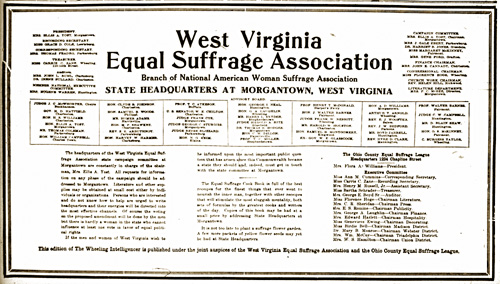
West Virginia Equal Suffrage Association. The Wheeling Intelligencer, May 1, 1916
 Suffragists selling the Wheeling newspaper from automobile. The Wheeling Intelligencer, May 2, 1916 |
On May 1, The Wheeling Intelligencer, with more than 13,000 subscribers, included a woman suffrage section in its newspaper. The WVESA sent additional copies to each of the county suffrage societies, and women connected to the Ohio County and Wheeling organizations set up automobile newstands in several locations in Wheeling. Mrs. George Laughlin, Mrs. Robert Hazelett, Henrietta Romine, Mrs. W. D. McCoy, Mrs. Gibson Caldwell, Anne Cummins, Elizabeth Cummins, Mary Clifford, Gladys Dexter, Florence Hoge, and Ruth Mason of Wheeling manned the automobiles. The Clarksburg Daily Telegram published a similiar issue in August. | 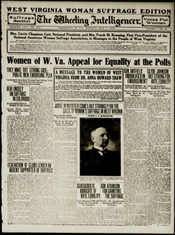 First page of suffrage section of The Wheeling Intelligencer, May 1, 1916 |
The attitude of pro- and anti-suffrage sides was less combative mid-year than it soon would become--as evidenced by a baseball game between doctors and lawyers in Huntington in June, in which the former represented the antis and the latter the suffragists. The good-natured event had women on both sides present flowers to the players afterwards, and proceeds were split between suffragists, antis, and the summer playgrounds committee. The situation was less congenial by August, when local suffrage organizations issued an open letter alleging a relationship between Clara Markeson and liquour interests during the 1914 suffrage campaign in Montana.
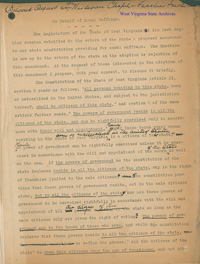 Roy Waugh speech, August 24, 1916. Roy Waugh Collection, West Virginia State Archives |
Among the pro-suffrage advocates who mentioned Markeson was Roy Waugh of Buckhannon, who spoke on behalf of woman suffrage on August 24 at a Teachers Institute in Buckhannon. Waugh also disputed the reasons suffrage opponents presented as to why women should not vote. Waugh was part of the pro-suffrage "flying squadron" of speakers, mostly men but including a few women, who toured the state in the final months of the campaign in support of suffrage referendum. Others in the group included Judge J. C. McWhorter, also of Buckhannon, who made about two dozen speeches; Joseph Bennett of Sistersville, C. Burgess Taylor of Wheeling, Charles E. Carrigan of Moundsville, Howard Swisher and Frank Cox of Morgantown, Tracy Jeffords of Harpers Ferry, Harvey Harmer of Clarksburg, Nancy Mann of Huntington, and Flora Williams, soloist, of Wheeling. Several out-of-state suffragists also spoke around the state, among them Anna Howard Shaw and Carrie Chapman Catt, then president of the NAWSA. |
 Roy Waugh. Who's Who in West Virginia, 1916 |
 J. C. McWhorter. Bench and Bar of West Virginia, 1919 |
The results of the election stunned West Virginia's suffrage supporters. When the votes had been counted, the suffrage referendum had experienced an overwhelming defeat, 162,158 to 63,540. In only two counties, Brooke and Hancock, did a majority of male voters support the measure. (See county breakdown)  Map of the West Virginia county vote in the 1916 suffrage referendum, created by West Virginia Archives and History
Primary Documents:Comments of Huntington Women Responding to Informal Referendum, 1915"Suffragists Begin Work of Education," by Harriet B. Jones, 1915 Mary Simms Keller Anti-Suffrage Letter, 1916 Letters of Gubernatorial Candidates John J. Cornwell and Ira A. Robinson, 1916 Nancy Mann Suffrage Speech, 1916 Judge Frank Cox Opinion on Law and Women Jurors, 1916 Remarks of Judge J. C. McWhorter on Women Suffrage and Taxation, 1916 Letter of Woman Suffrage Opponent W. W. Brannon, 1916  | |||||||||||||
